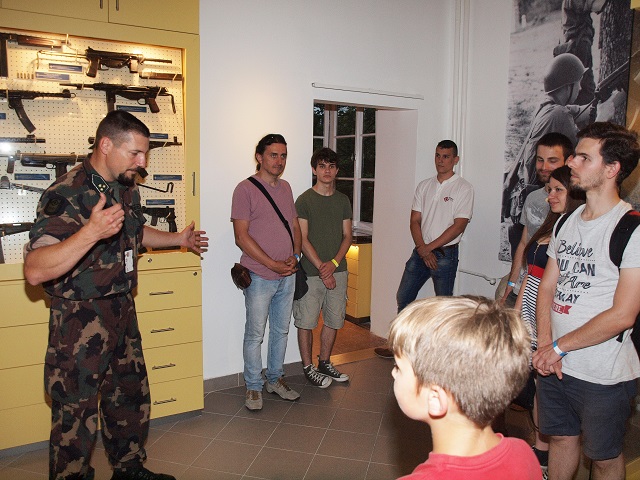May 2005 saw the opening of a massive and spectacular exhibition titled “From the Piave to the Don River – The Military History of Hungary 1918–1943.” Its sequel, “From the Don River to the Danube – The Military History of Hungary 1943–1948” was opened in 2006. The permanent exhibition presenting the military history of Hungary between 1948 and 1956, titled “Gratitude to the Heroes of Freedom” had been completed by October 2006, on the 50th anniversary of the Revolution, to be expanded in the following year to include the period until 1968, under the title “…and the Iron Curtain Has Fallen.” In November 2008, on the 90th anniversary of the end of the First World War, the exhibition titled “By the Time the Leaves Fall… and They Have Fallen” was ceremonially opened. The display representing Hungary’s military history between 1867 and 1914 was opened in the autumn of 2010.
The successful activity of the Military History Institute and Museum and its staff was acknowledged by two distinguished awards, the Hungarian Heritage Prize in 2009 and the “Museum of the Year” award for the second time in 2010.
After a pause of one and a half decades, the scientific Yearbook of the Military History Museum, which was first published in 1971, has been issued on an annual basis since 2000. The volumes include articles on various military history topics; there is a vast amount of interesting information regarding the Museum’s history, collections, and artefacts of significant importance, written by the Museum’s curators.
Colleagues of the Museum have taken an active part in the production of the Institution’s publications, the number of which has significantly increased in the recent years. Among these, the series of “slipcase books” are truly special, and are based on a concept that is considered an absolute novelty in Hungary, offering “touchable military history” to the reader: between the pages, in pockets, authentic reprints of original documents can be found.
In recent years, the complex use of digital technology has increasingly assisted documentation and exhibition projects at the Museum. With the help of various funding opportunities, the Museum participates in national and international projects, making it possible for its activities and collections to be presented to a wide public.
As a result of a change of approach, today’s permanent exhibitons are characterised by interactivity besides a wealth of artefacts and information.
The exhibition introducing the years 1815–1867, with special focus on the 1848–1849 Revolution and War of Independence, titled “Our Catchwords Were: Homeland and Progress” has been open to the public since 2013.
As a branch of the Military History Institute and Museum, the Commemorative Exhibition of the Battle of Pákozd-Sukoró was opened in the spring of 2014 and in the same year, the Lajta Monitor Museum Ship was anchored in front of the Parliament building in Budapest for the first time. The onetime river gunboat also toured the Danube between April and May 2018 attracting masses of people in several towns along the river.
For the centenary of the First World War, a travelling exhibition titled “Four Years in Blood and Iron – The Great War, 1914–1918” was created, and began its journey throughout the country in the summer of 2014. In 2016, a new permanent exhibition titled “Hungary in the Great War, 1914–1918” was opened as part of the centennial commemorations, fulfilling modern museum requirements. Simultaneously, the exhibition titled “Under the Flags of Francis Joseph – The Military History of Hungary, 1868–1914”, presenting the Belle Époque, was also renewed.
A part of the exhibition organised for the centenary of the First World War
Museum education programme on the occasion of the Hungarian national holiday on 15 March
With the support of the Gulag Memorial Committee, the permanent exhibition titled “Deported, Far From Home – Hungarian Soldiers in Soviet Captivity, 1941–1955” was opened, while the 1956 Remembrance Committee financed the creation of the travelling exhibition titled “56 Teardrops – Women’s Fate in the Days of the 1956 Revolution and War of Independence and During the Years of Retaliation.”
In 2017, at the Night of Museums the “Armoury – Visible Storage of Weaponry” opened its gates to the public. The Armoury aims to present the weapons, clothing and equipment of Hungarian soldiers from the 10th century to present. The changes in warfare and tactics are shown through the evolution of military tools from the bow to the machine gun, from the mail armour to modern bulletproof and fragmentation vests.

The opening of the Armoury at the Night of Museums in 2017
The Military History Museum continuosly cooperates with most national and county museums, and occasionally with local museums, educational institutions, municipalities and civilian organizations. It maintains bilateral relations with museums and other organizations related to historical research from nine countries.
Among these, an outstandingly significant project bridging boundaries aimed at the scientifical processing and publishing of the artefacts and documents of the former 1848–1849 Arad Relics Museum as part of an international (Hungarian–Romanian) cooperation lasting for years.
For want of space, the Museum’s international network of connections, which characterised the Institution from the very beginning, i.e. the foundation of the Museum, cannot be discussed in detail here. The Museum presents various periods and relics of Hungarian military history in exhibitions throughout Europe, from Istanbul to Helsinki, from Moscow to Brussels. From the late 1980s, relations have strengthened particularly with First World War memorial sites; the Museum has permanent and temporary exhibitions, renewed from time to time, in Vittoria (Sicily), Kobarid (Slovenia), Oberdrauburg and Kötschach-Mauthen (Austria), Przemysl and Gorlice (Poland), to mention a few. Visitors can also see displays created by the Museum for example in Washingtom (USA), Brussels (Belgium) and at various NATO bases.
Moving a cannon back to its traditional place in front of the main entrance of the Museum, 17 May 2017



